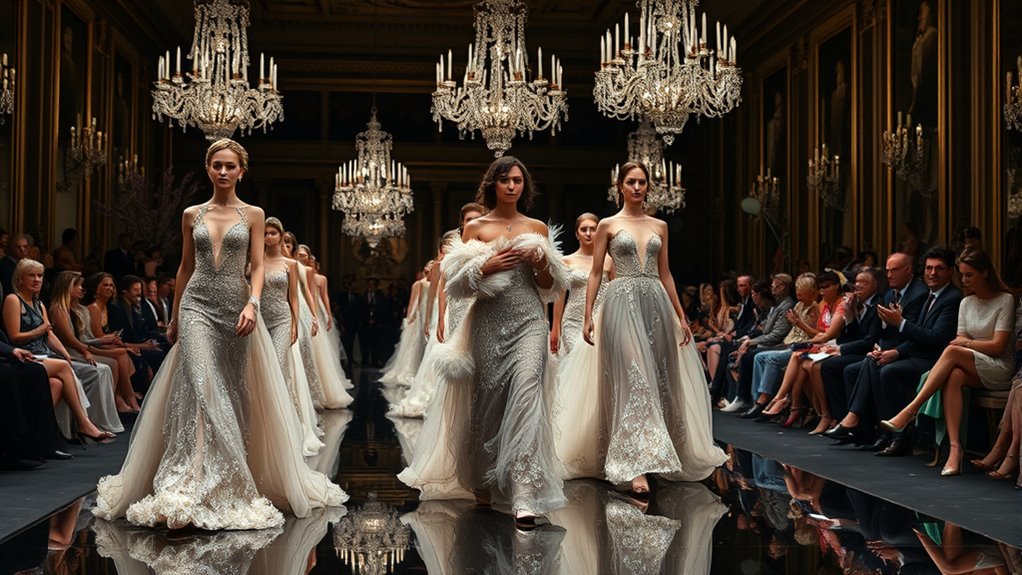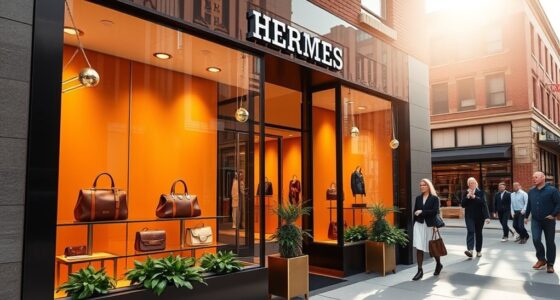The evolution of haute couture shows how high fashion blends artistry, technology, and sustainability. You’ll see brands shifting to eco-friendly materials, embracing digital tools like AR and 3D printing, and making fashion more inclusive and responsible. This dynamic field keeps innovating, combining craftsmanship with modern innovations, and adapting to societal needs. If you’re curious about the latest trends and how tradition meets the future, there’s much more to explore ahead.
Key Takeaways
- Haute couture has evolved from traditional craftsmanship to incorporate digital innovations like 3D printing and virtual try-ons.
- The fashion industry now emphasizes sustainability, using eco-friendly materials and ethical manufacturing practices.
- Digital tools enable global access, live-streamed runway shows, and increased creativity in high fashion design.
- Industry dynamics have shifted, making haute couture more inclusive, responsible, and adaptable to societal changes.
- Future trends focus on merging environmental sustainability with technological advancements to shape high fashion’s next era.

Have you ever wondered how high fashion has transformed over the years? It’s a fascinating journey that reflects both societal change and technological progress. Today, the world of haute couture is more dynamic than ever, driven by a blend of sustainable practices and digital innovation. These forces are reshaping how designers create, present, and even think about fashion. Gone are the days when craftsmanship alone dictated luxury; now, there’s a conscious effort to reduce environmental impact while embracing cutting-edge technology.
Sustainable practices have become a core part of high fashion’s evolution. You see brands shifting toward eco-friendly materials, such as organic fabrics and recycled textiles, aiming to minimize their carbon footprint. This shift isn’t just about trendiness but a genuine response to environmental concerns. Designers are increasingly transparent about their supply chains, ensuring that every step of production adheres to ethical standards. You’ll notice fewer wasteful processes and more focus on longevity, with some labels even offering repair and reuse programs. This shift toward sustainability reflects a broader cultural movement where consumers are more conscious of their choices and seek brands that align with their values. High fashion isn’t just about exclusivity anymore; it’s about responsibility too.
Simultaneously, digital innovation is transforming every aspect of haute couture. You’re now able to experience runway shows from your living room via live streams, reaching a global audience instantly. Virtual fitting rooms, augmented reality apps, and 3D design tools are changing how you interact with fashion. Designers leverage these technologies to experiment with new forms and fabrics, pushing boundaries that traditional methods couldn’t easily explore. Digital platforms also facilitate faster production cycles, allowing brands to respond swiftly to changing trends without sacrificing quality. furthermore, 3D printing is making it possible to create intricate, customized pieces with less waste, aligning with sustainable goals. This fusion of digital tools and craftsmanship not only enhances creativity but also makes high fashion more accessible and innovative. Additionally, integrating top mattress toppers and ergonomic design principles can improve comfort in fashion accessories, reflecting a broader trend of merging comfort with style.
Ultimately, this evolution signifies that haute couture is no longer confined to exclusive ateliers behind closed doors. It’s a living, breathing industry that adapts to environmental needs and technological possibilities. As you follow these changes, it’s clear that the future of high fashion will continue to integrate sustainable practices and digital innovation, making it more responsible, inclusive, and inventive. The landscape might have shifted from traditional hand-sewn masterpieces to high-tech marvels, but at its core, it remains a celebration of artistry and vision—just now, with a conscious eye on the planet and a digital eye on the horizon.
Frequently Asked Questions
How Has Technology Influenced Haute Couture Design Processes?
You see, technology has transformed haute couture design processes by enabling you to experiment more creatively. With digital textiles, you can explore innovative fabrics and patterns that weren’t possible before. 3D printing allows you to create intricate, customized accessories and garments with precision. These tools help you streamline production, reduce waste, and push the boundaries of traditional fashion, making haute couture more innovative, sustainable, and personalized.
What Are the Environmental Impacts of High Fashion Manufacturing?
Think of high fashion manufacturing as a double-edged sword—you want stunning designs, but it often leaves an environmental scar. You can make a difference by adopting sustainable practices and choosing eco-friendly materials. These efforts reduce waste, lower carbon footprints, and protect ecosystems. By supporting brands that prioritize sustainability, you help turn the fashion industry into a greener, more responsible space, ensuring style doesn’t come at the planet’s expense.
How Do Cultural Shifts Affect Haute Couture Trends?
You see that cultural shifts influence haute couture trends by shaping what’s considered fashionable, often reflecting cultural symbolism. As fashion globalization accelerates, designers draw inspiration from diverse traditions, blending them into high fashion collections. This exchange fosters innovation but also raises questions about cultural appropriation. Your awareness of these dynamics helps you understand how evolving societal values and global interconnectedness continuously redefine haute couture’s creative landscape.
What Is the Role of Social Media in Shaping Haute Couture Popularity?
Social media influence plays a huge role in shaping haute couture popularity today. You see, celebrity endorsements on platforms like Instagram and TikTok boost designer visibility instantly. When celebrities wear exclusive pieces, it sparks desire and sets trends that fans and fashion enthusiasts follow. This direct connection between designers, celebrities, and audiences accelerates the hype, making haute couture more accessible and desirable than ever before.
How Do Haute Couture Houses Protect Their Intellectual Property?
Imagine your unique design being copied overnight—haute couture houses fight to keep that from happening. They protect their intellectual property through trademark enforcement, ensuring their brand remains exclusive, and design registration, which legally safeguards their original creations. By actively monitoring for infringements and taking swift legal action, they defend their artistry and reputation in a world where imitation can threaten true innovation.
Conclusion
As you explore haute couture’s journey, remember it’s like a delicate butterfly emerging from a cocoon—transforming tradition into art. Just last year, a designer’s intricate gown took over 1,000 hours to craft, symbolizing the relentless passion behind high fashion. This evolution isn’t just about clothes; it’s about pushing boundaries and daring to dream bigger. So, keep watching—because in fashion, as in life, transformation is the most beautiful thing you can witness.










